Understanding Indigenous Cinema and Identity
VerifiedAdded on 2020/07/22
|9
|2711
|227
AI Summary
This assignment discusses the importance of government support in developing a society where each individual can grow positively. It highlights the role of government in supporting initiatives that promote respect and understanding, particularly through indigenous cinema. The assignment also touches upon the reception of Australian films like 'Samson and Delilah' in Germany, showcasing the impact of cultural context on film perception.
Contribute Materials
Your contribution can guide someone’s learning journey. Share your
documents today.
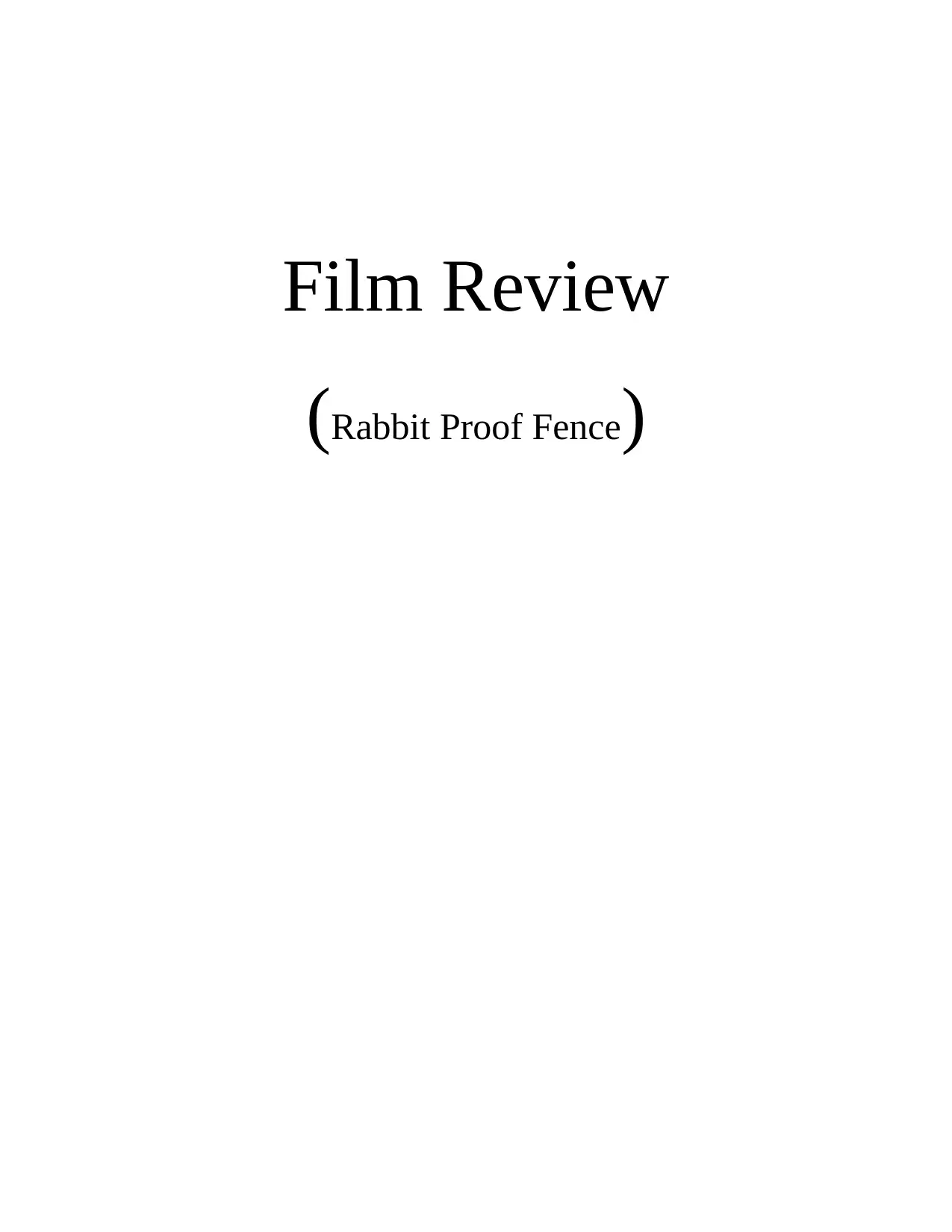
Film Review
(Rabbit Proof Fence)
(Rabbit Proof Fence)
Secure Best Marks with AI Grader
Need help grading? Try our AI Grader for instant feedback on your assignments.
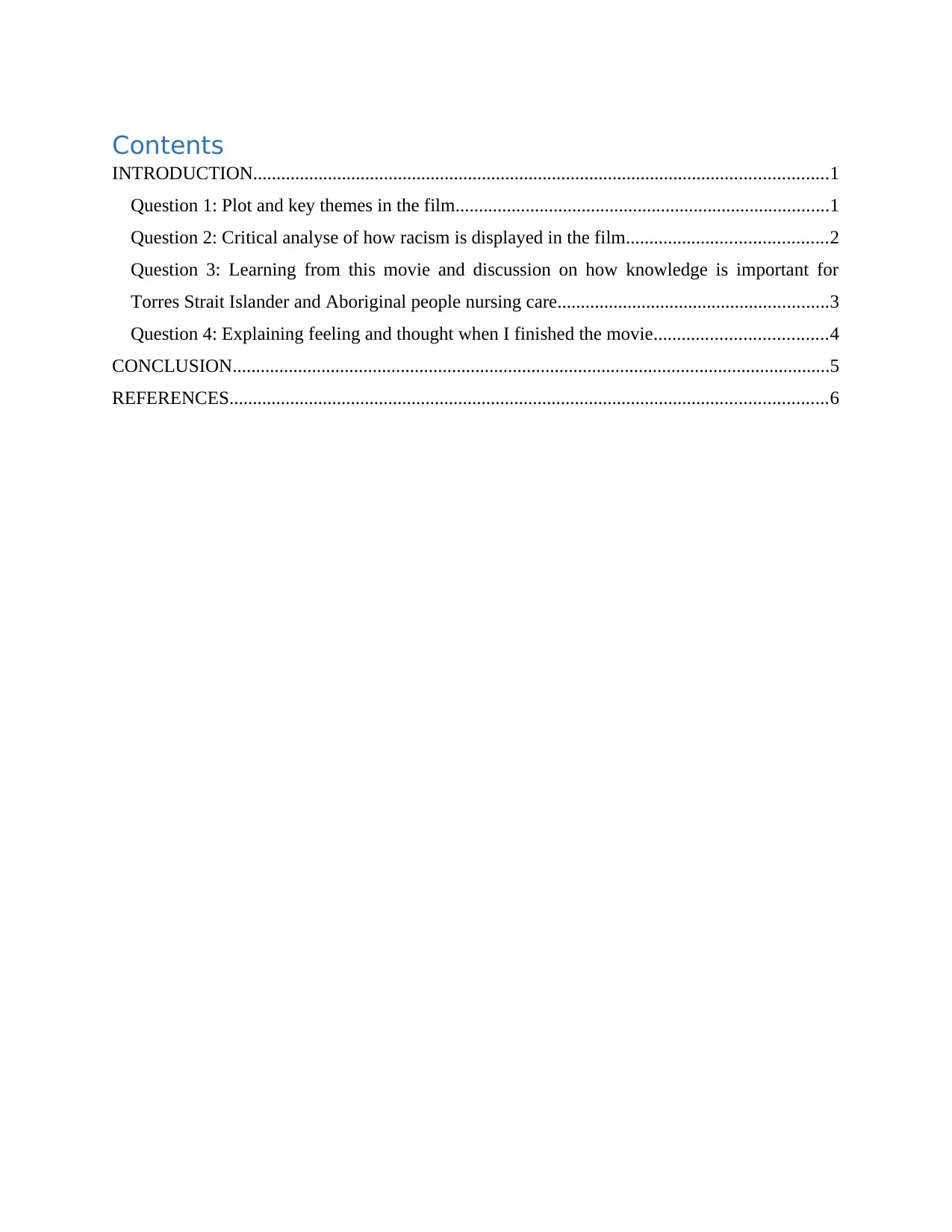
Contents
INTRODUCTION...........................................................................................................................1
Question 1: Plot and key themes in the film................................................................................1
Question 2: Critical analyse of how racism is displayed in the film...........................................2
Question 3: Learning from this movie and discussion on how knowledge is important for
Torres Strait Islander and Aboriginal people nursing care..........................................................3
Question 4: Explaining feeling and thought when I finished the movie.....................................4
CONCLUSION................................................................................................................................5
REFERENCES................................................................................................................................6
INTRODUCTION...........................................................................................................................1
Question 1: Plot and key themes in the film................................................................................1
Question 2: Critical analyse of how racism is displayed in the film...........................................2
Question 3: Learning from this movie and discussion on how knowledge is important for
Torres Strait Islander and Aboriginal people nursing care..........................................................3
Question 4: Explaining feeling and thought when I finished the movie.....................................4
CONCLUSION................................................................................................................................5
REFERENCES................................................................................................................................6
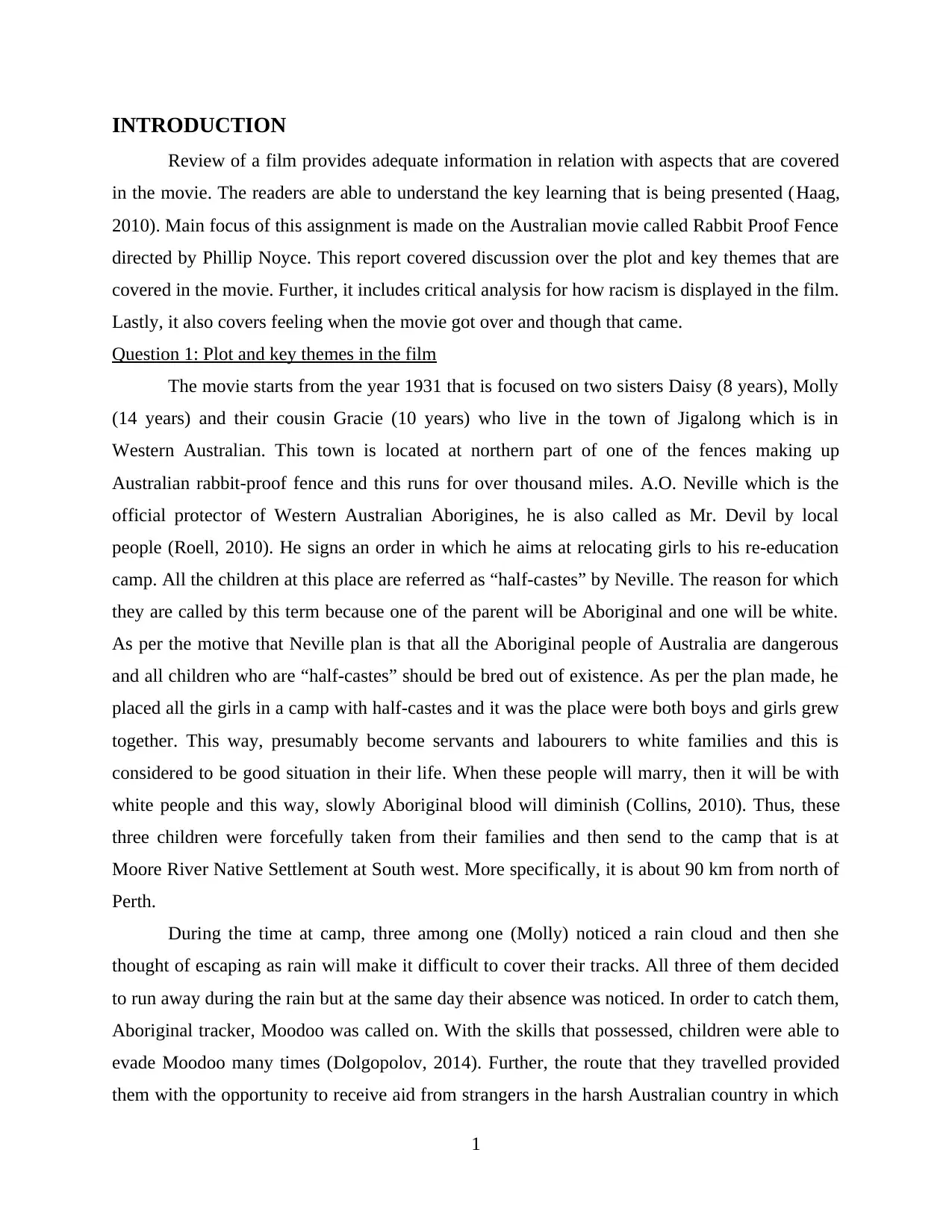
INTRODUCTION
Review of a film provides adequate information in relation with aspects that are covered
in the movie. The readers are able to understand the key learning that is being presented (Haag,
2010). Main focus of this assignment is made on the Australian movie called Rabbit Proof Fence
directed by Phillip Noyce. This report covered discussion over the plot and key themes that are
covered in the movie. Further, it includes critical analysis for how racism is displayed in the film.
Lastly, it also covers feeling when the movie got over and though that came.
Question 1: Plot and key themes in the film
The movie starts from the year 1931 that is focused on two sisters Daisy (8 years), Molly
(14 years) and their cousin Gracie (10 years) who live in the town of Jigalong which is in
Western Australian. This town is located at northern part of one of the fences making up
Australian rabbit-proof fence and this runs for over thousand miles. A.O. Neville which is the
official protector of Western Australian Aborigines, he is also called as Mr. Devil by local
people (Roell, 2010). He signs an order in which he aims at relocating girls to his re-education
camp. All the children at this place are referred as “half-castes” by Neville. The reason for which
they are called by this term because one of the parent will be Aboriginal and one will be white.
As per the motive that Neville plan is that all the Aboriginal people of Australia are dangerous
and all children who are “half-castes” should be bred out of existence. As per the plan made, he
placed all the girls in a camp with half-castes and it was the place were both boys and girls grew
together. This way, presumably become servants and labourers to white families and this is
considered to be good situation in their life. When these people will marry, then it will be with
white people and this way, slowly Aboriginal blood will diminish (Collins, 2010). Thus, these
three children were forcefully taken from their families and then send to the camp that is at
Moore River Native Settlement at South west. More specifically, it is about 90 km from north of
Perth.
During the time at camp, three among one (Molly) noticed a rain cloud and then she
thought of escaping as rain will make it difficult to cover their tracks. All three of them decided
to run away during the rain but at the same day their absence was noticed. In order to catch them,
Aboriginal tracker, Moodoo was called on. With the skills that possessed, children were able to
evade Moodoo many times (Dolgopolov, 2014). Further, the route that they travelled provided
them with the opportunity to receive aid from strangers in the harsh Australian country in which
1
Review of a film provides adequate information in relation with aspects that are covered
in the movie. The readers are able to understand the key learning that is being presented (Haag,
2010). Main focus of this assignment is made on the Australian movie called Rabbit Proof Fence
directed by Phillip Noyce. This report covered discussion over the plot and key themes that are
covered in the movie. Further, it includes critical analysis for how racism is displayed in the film.
Lastly, it also covers feeling when the movie got over and though that came.
Question 1: Plot and key themes in the film
The movie starts from the year 1931 that is focused on two sisters Daisy (8 years), Molly
(14 years) and their cousin Gracie (10 years) who live in the town of Jigalong which is in
Western Australian. This town is located at northern part of one of the fences making up
Australian rabbit-proof fence and this runs for over thousand miles. A.O. Neville which is the
official protector of Western Australian Aborigines, he is also called as Mr. Devil by local
people (Roell, 2010). He signs an order in which he aims at relocating girls to his re-education
camp. All the children at this place are referred as “half-castes” by Neville. The reason for which
they are called by this term because one of the parent will be Aboriginal and one will be white.
As per the motive that Neville plan is that all the Aboriginal people of Australia are dangerous
and all children who are “half-castes” should be bred out of existence. As per the plan made, he
placed all the girls in a camp with half-castes and it was the place were both boys and girls grew
together. This way, presumably become servants and labourers to white families and this is
considered to be good situation in their life. When these people will marry, then it will be with
white people and this way, slowly Aboriginal blood will diminish (Collins, 2010). Thus, these
three children were forcefully taken from their families and then send to the camp that is at
Moore River Native Settlement at South west. More specifically, it is about 90 km from north of
Perth.
During the time at camp, three among one (Molly) noticed a rain cloud and then she
thought of escaping as rain will make it difficult to cover their tracks. All three of them decided
to run away during the rain but at the same day their absence was noticed. In order to catch them,
Aboriginal tracker, Moodoo was called on. With the skills that possessed, children were able to
evade Moodoo many times (Dolgopolov, 2014). Further, the route that they travelled provided
them with the opportunity to receive aid from strangers in the harsh Australian country in which
1
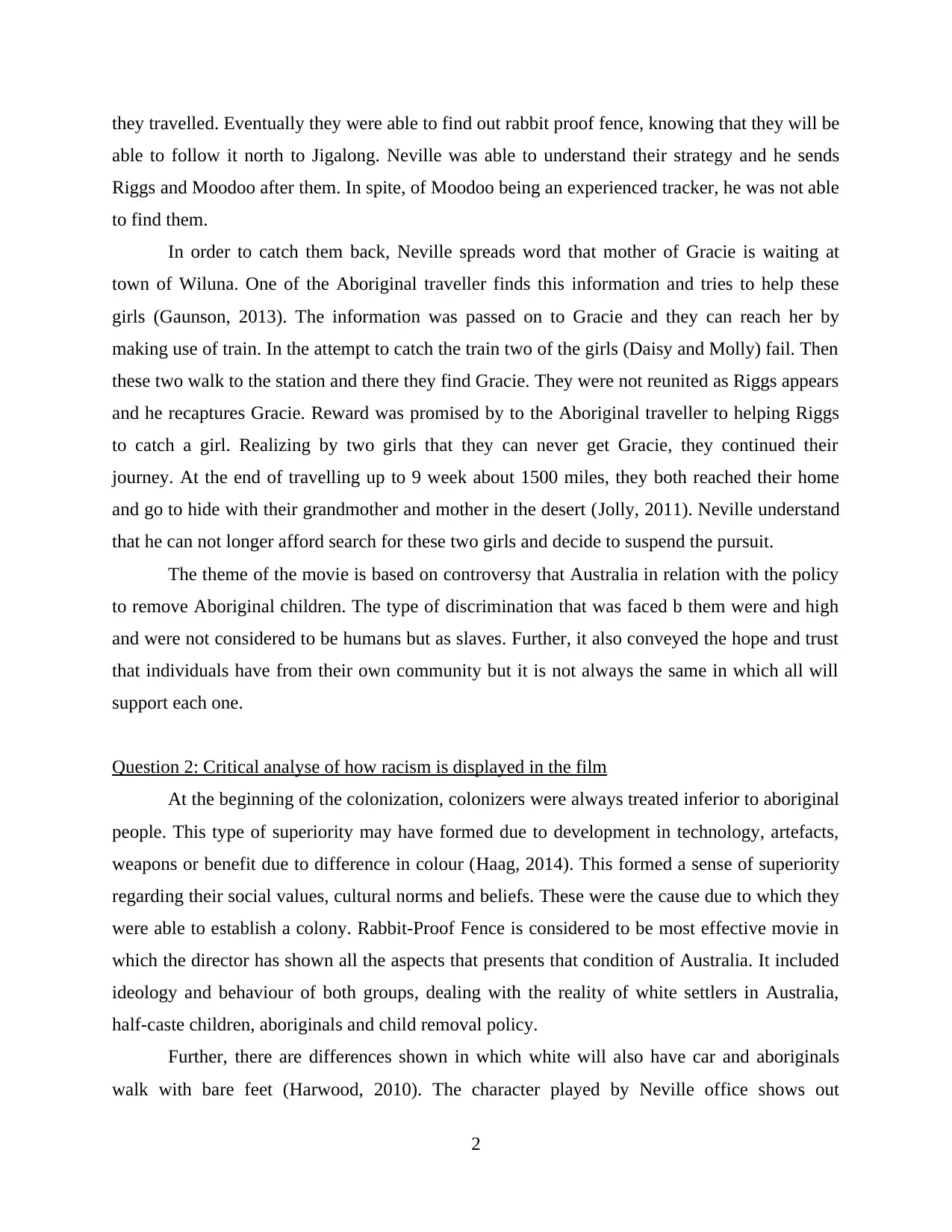
they travelled. Eventually they were able to find out rabbit proof fence, knowing that they will be
able to follow it north to Jigalong. Neville was able to understand their strategy and he sends
Riggs and Moodoo after them. In spite, of Moodoo being an experienced tracker, he was not able
to find them.
In order to catch them back, Neville spreads word that mother of Gracie is waiting at
town of Wiluna. One of the Aboriginal traveller finds this information and tries to help these
girls (Gaunson, 2013). The information was passed on to Gracie and they can reach her by
making use of train. In the attempt to catch the train two of the girls (Daisy and Molly) fail. Then
these two walk to the station and there they find Gracie. They were not reunited as Riggs appears
and he recaptures Gracie. Reward was promised by to the Aboriginal traveller to helping Riggs
to catch a girl. Realizing by two girls that they can never get Gracie, they continued their
journey. At the end of travelling up to 9 week about 1500 miles, they both reached their home
and go to hide with their grandmother and mother in the desert (Jolly, 2011). Neville understand
that he can not longer afford search for these two girls and decide to suspend the pursuit.
The theme of the movie is based on controversy that Australia in relation with the policy
to remove Aboriginal children. The type of discrimination that was faced b them were and high
and were not considered to be humans but as slaves. Further, it also conveyed the hope and trust
that individuals have from their own community but it is not always the same in which all will
support each one.
Question 2: Critical analyse of how racism is displayed in the film
At the beginning of the colonization, colonizers were always treated inferior to aboriginal
people. This type of superiority may have formed due to development in technology, artefacts,
weapons or benefit due to difference in colour (Haag, 2014). This formed a sense of superiority
regarding their social values, cultural norms and beliefs. These were the cause due to which they
were able to establish a colony. Rabbit-Proof Fence is considered to be most effective movie in
which the director has shown all the aspects that presents that condition of Australia. It included
ideology and behaviour of both groups, dealing with the reality of white settlers in Australia,
half-caste children, aboriginals and child removal policy.
Further, there are differences shown in which white will also have car and aboriginals
walk with bare feet (Harwood, 2010). The character played by Neville office shows out
2
able to follow it north to Jigalong. Neville was able to understand their strategy and he sends
Riggs and Moodoo after them. In spite, of Moodoo being an experienced tracker, he was not able
to find them.
In order to catch them back, Neville spreads word that mother of Gracie is waiting at
town of Wiluna. One of the Aboriginal traveller finds this information and tries to help these
girls (Gaunson, 2013). The information was passed on to Gracie and they can reach her by
making use of train. In the attempt to catch the train two of the girls (Daisy and Molly) fail. Then
these two walk to the station and there they find Gracie. They were not reunited as Riggs appears
and he recaptures Gracie. Reward was promised by to the Aboriginal traveller to helping Riggs
to catch a girl. Realizing by two girls that they can never get Gracie, they continued their
journey. At the end of travelling up to 9 week about 1500 miles, they both reached their home
and go to hide with their grandmother and mother in the desert (Jolly, 2011). Neville understand
that he can not longer afford search for these two girls and decide to suspend the pursuit.
The theme of the movie is based on controversy that Australia in relation with the policy
to remove Aboriginal children. The type of discrimination that was faced b them were and high
and were not considered to be humans but as slaves. Further, it also conveyed the hope and trust
that individuals have from their own community but it is not always the same in which all will
support each one.
Question 2: Critical analyse of how racism is displayed in the film
At the beginning of the colonization, colonizers were always treated inferior to aboriginal
people. This type of superiority may have formed due to development in technology, artefacts,
weapons or benefit due to difference in colour (Haag, 2014). This formed a sense of superiority
regarding their social values, cultural norms and beliefs. These were the cause due to which they
were able to establish a colony. Rabbit-Proof Fence is considered to be most effective movie in
which the director has shown all the aspects that presents that condition of Australia. It included
ideology and behaviour of both groups, dealing with the reality of white settlers in Australia,
half-caste children, aboriginals and child removal policy.
Further, there are differences shown in which white will also have car and aboriginals
walk with bare feet (Harwood, 2010). The character played by Neville office shows out
2
Secure Best Marks with AI Grader
Need help grading? Try our AI Grader for instant feedback on your assignments.
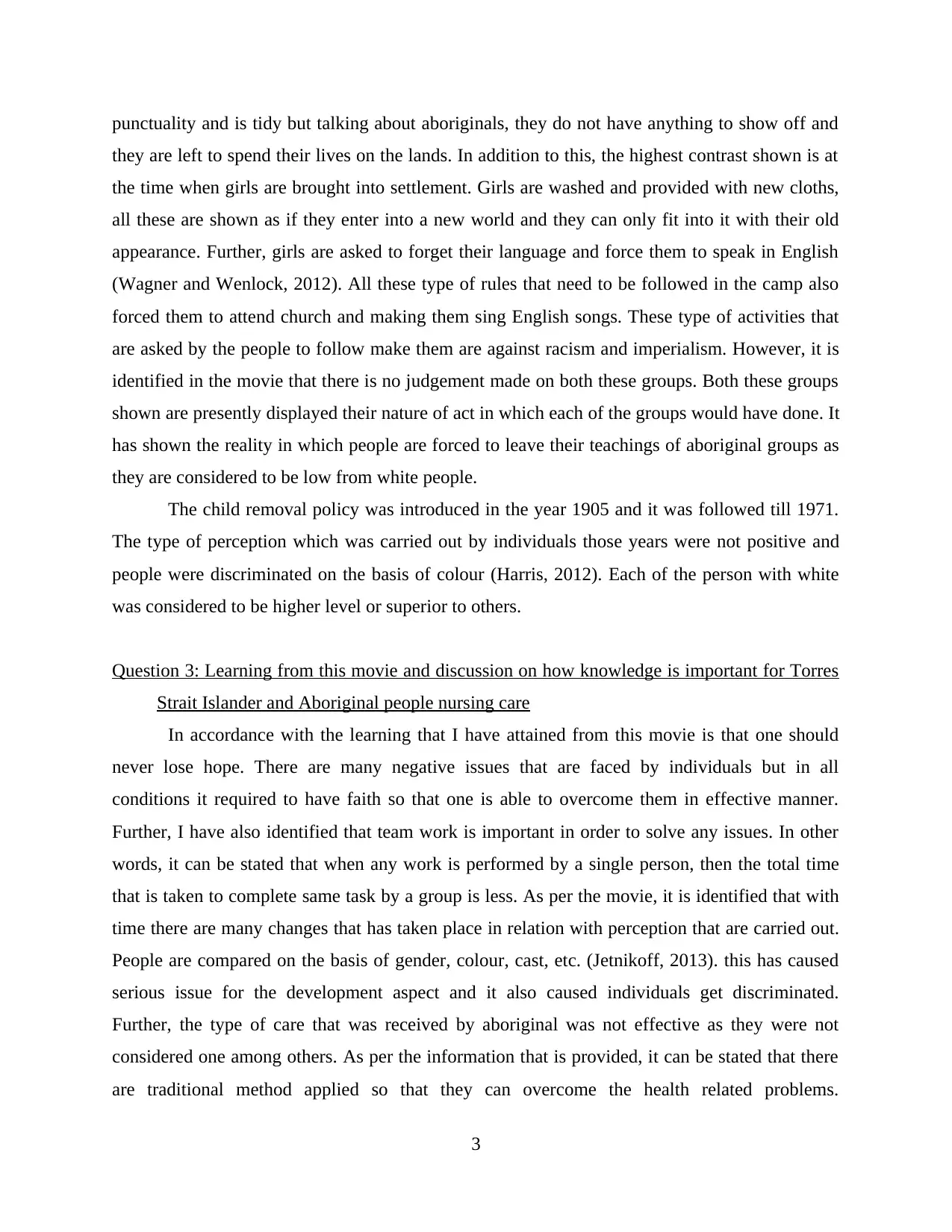
punctuality and is tidy but talking about aboriginals, they do not have anything to show off and
they are left to spend their lives on the lands. In addition to this, the highest contrast shown is at
the time when girls are brought into settlement. Girls are washed and provided with new cloths,
all these are shown as if they enter into a new world and they can only fit into it with their old
appearance. Further, girls are asked to forget their language and force them to speak in English
(Wagner and Wenlock, 2012). All these type of rules that need to be followed in the camp also
forced them to attend church and making them sing English songs. These type of activities that
are asked by the people to follow make them are against racism and imperialism. However, it is
identified in the movie that there is no judgement made on both these groups. Both these groups
shown are presently displayed their nature of act in which each of the groups would have done. It
has shown the reality in which people are forced to leave their teachings of aboriginal groups as
they are considered to be low from white people.
The child removal policy was introduced in the year 1905 and it was followed till 1971.
The type of perception which was carried out by individuals those years were not positive and
people were discriminated on the basis of colour (Harris, 2012). Each of the person with white
was considered to be higher level or superior to others.
Question 3: Learning from this movie and discussion on how knowledge is important for Torres
Strait Islander and Aboriginal people nursing care
In accordance with the learning that I have attained from this movie is that one should
never lose hope. There are many negative issues that are faced by individuals but in all
conditions it required to have faith so that one is able to overcome them in effective manner.
Further, I have also identified that team work is important in order to solve any issues. In other
words, it can be stated that when any work is performed by a single person, then the total time
that is taken to complete same task by a group is less. As per the movie, it is identified that with
time there are many changes that has taken place in relation with perception that are carried out.
People are compared on the basis of gender, colour, cast, etc. (Jetnikoff, 2013). this has caused
serious issue for the development aspect and it also caused individuals get discriminated.
Further, the type of care that was received by aboriginal was not effective as they were not
considered one among others. As per the information that is provided, it can be stated that there
are traditional method applied so that they can overcome the health related problems.
3
they are left to spend their lives on the lands. In addition to this, the highest contrast shown is at
the time when girls are brought into settlement. Girls are washed and provided with new cloths,
all these are shown as if they enter into a new world and they can only fit into it with their old
appearance. Further, girls are asked to forget their language and force them to speak in English
(Wagner and Wenlock, 2012). All these type of rules that need to be followed in the camp also
forced them to attend church and making them sing English songs. These type of activities that
are asked by the people to follow make them are against racism and imperialism. However, it is
identified in the movie that there is no judgement made on both these groups. Both these groups
shown are presently displayed their nature of act in which each of the groups would have done. It
has shown the reality in which people are forced to leave their teachings of aboriginal groups as
they are considered to be low from white people.
The child removal policy was introduced in the year 1905 and it was followed till 1971.
The type of perception which was carried out by individuals those years were not positive and
people were discriminated on the basis of colour (Harris, 2012). Each of the person with white
was considered to be higher level or superior to others.
Question 3: Learning from this movie and discussion on how knowledge is important for Torres
Strait Islander and Aboriginal people nursing care
In accordance with the learning that I have attained from this movie is that one should
never lose hope. There are many negative issues that are faced by individuals but in all
conditions it required to have faith so that one is able to overcome them in effective manner.
Further, I have also identified that team work is important in order to solve any issues. In other
words, it can be stated that when any work is performed by a single person, then the total time
that is taken to complete same task by a group is less. As per the movie, it is identified that with
time there are many changes that has taken place in relation with perception that are carried out.
People are compared on the basis of gender, colour, cast, etc. (Jetnikoff, 2013). this has caused
serious issue for the development aspect and it also caused individuals get discriminated.
Further, the type of care that was received by aboriginal was not effective as they were not
considered one among others. As per the information that is provided, it can be stated that there
are traditional method applied so that they can overcome the health related problems.
3
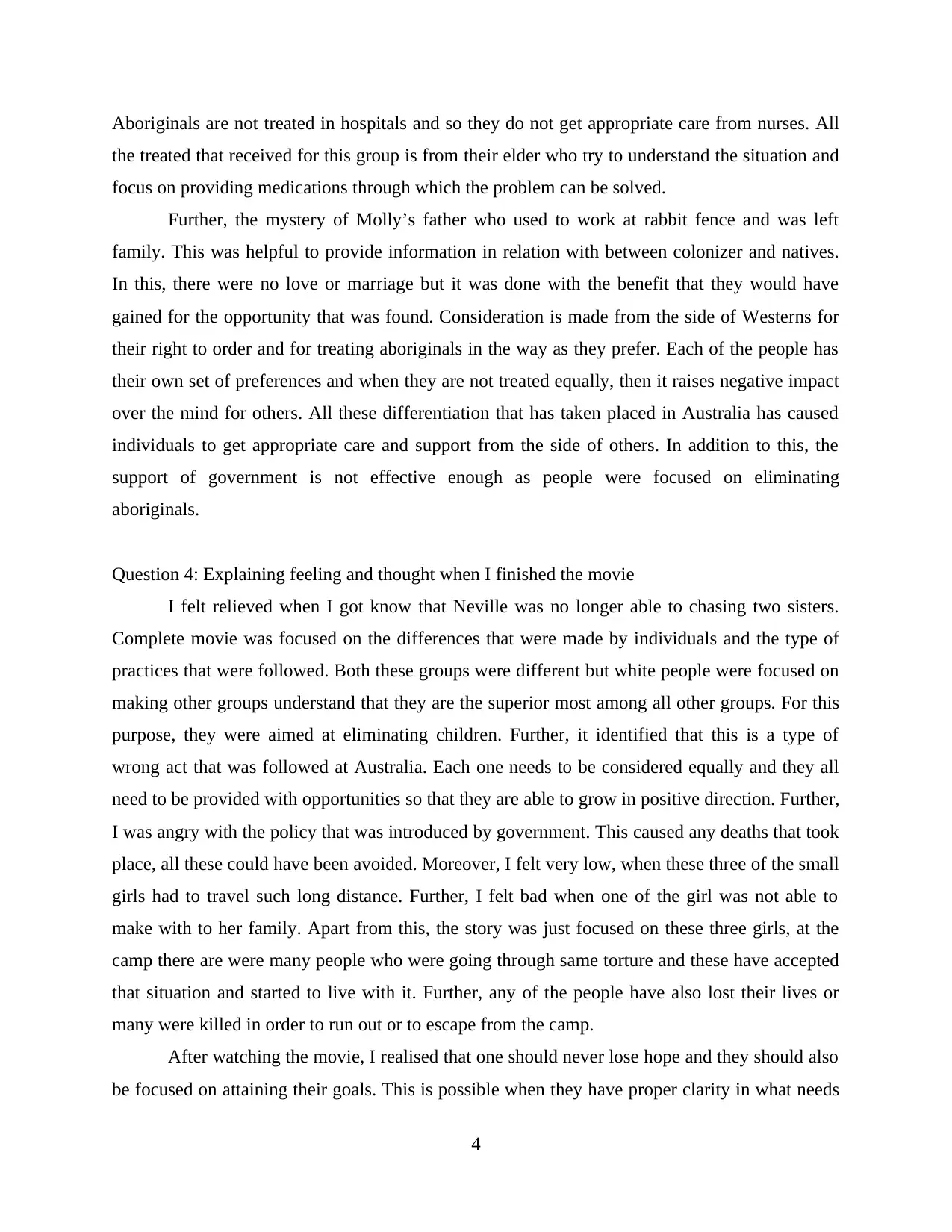
Aboriginals are not treated in hospitals and so they do not get appropriate care from nurses. All
the treated that received for this group is from their elder who try to understand the situation and
focus on providing medications through which the problem can be solved.
Further, the mystery of Molly’s father who used to work at rabbit fence and was left
family. This was helpful to provide information in relation with between colonizer and natives.
In this, there were no love or marriage but it was done with the benefit that they would have
gained for the opportunity that was found. Consideration is made from the side of Westerns for
their right to order and for treating aboriginals in the way as they prefer. Each of the people has
their own set of preferences and when they are not treated equally, then it raises negative impact
over the mind for others. All these differentiation that has taken placed in Australia has caused
individuals to get appropriate care and support from the side of others. In addition to this, the
support of government is not effective enough as people were focused on eliminating
aboriginals.
Question 4: Explaining feeling and thought when I finished the movie
I felt relieved when I got know that Neville was no longer able to chasing two sisters.
Complete movie was focused on the differences that were made by individuals and the type of
practices that were followed. Both these groups were different but white people were focused on
making other groups understand that they are the superior most among all other groups. For this
purpose, they were aimed at eliminating children. Further, it identified that this is a type of
wrong act that was followed at Australia. Each one needs to be considered equally and they all
need to be provided with opportunities so that they are able to grow in positive direction. Further,
I was angry with the policy that was introduced by government. This caused any deaths that took
place, all these could have been avoided. Moreover, I felt very low, when these three of the small
girls had to travel such long distance. Further, I felt bad when one of the girl was not able to
make with to her family. Apart from this, the story was just focused on these three girls, at the
camp there are were many people who were going through same torture and these have accepted
that situation and started to live with it. Further, any of the people have also lost their lives or
many were killed in order to run out or to escape from the camp.
After watching the movie, I realised that one should never lose hope and they should also
be focused on attaining their goals. This is possible when they have proper clarity in what needs
4
the treated that received for this group is from their elder who try to understand the situation and
focus on providing medications through which the problem can be solved.
Further, the mystery of Molly’s father who used to work at rabbit fence and was left
family. This was helpful to provide information in relation with between colonizer and natives.
In this, there were no love or marriage but it was done with the benefit that they would have
gained for the opportunity that was found. Consideration is made from the side of Westerns for
their right to order and for treating aboriginals in the way as they prefer. Each of the people has
their own set of preferences and when they are not treated equally, then it raises negative impact
over the mind for others. All these differentiation that has taken placed in Australia has caused
individuals to get appropriate care and support from the side of others. In addition to this, the
support of government is not effective enough as people were focused on eliminating
aboriginals.
Question 4: Explaining feeling and thought when I finished the movie
I felt relieved when I got know that Neville was no longer able to chasing two sisters.
Complete movie was focused on the differences that were made by individuals and the type of
practices that were followed. Both these groups were different but white people were focused on
making other groups understand that they are the superior most among all other groups. For this
purpose, they were aimed at eliminating children. Further, it identified that this is a type of
wrong act that was followed at Australia. Each one needs to be considered equally and they all
need to be provided with opportunities so that they are able to grow in positive direction. Further,
I was angry with the policy that was introduced by government. This caused any deaths that took
place, all these could have been avoided. Moreover, I felt very low, when these three of the small
girls had to travel such long distance. Further, I felt bad when one of the girl was not able to
make with to her family. Apart from this, the story was just focused on these three girls, at the
camp there are were many people who were going through same torture and these have accepted
that situation and started to live with it. Further, any of the people have also lost their lives or
many were killed in order to run out or to escape from the camp.
After watching the movie, I realised that one should never lose hope and they should also
be focused on attaining their goals. This is possible when they have proper clarity in what needs
4
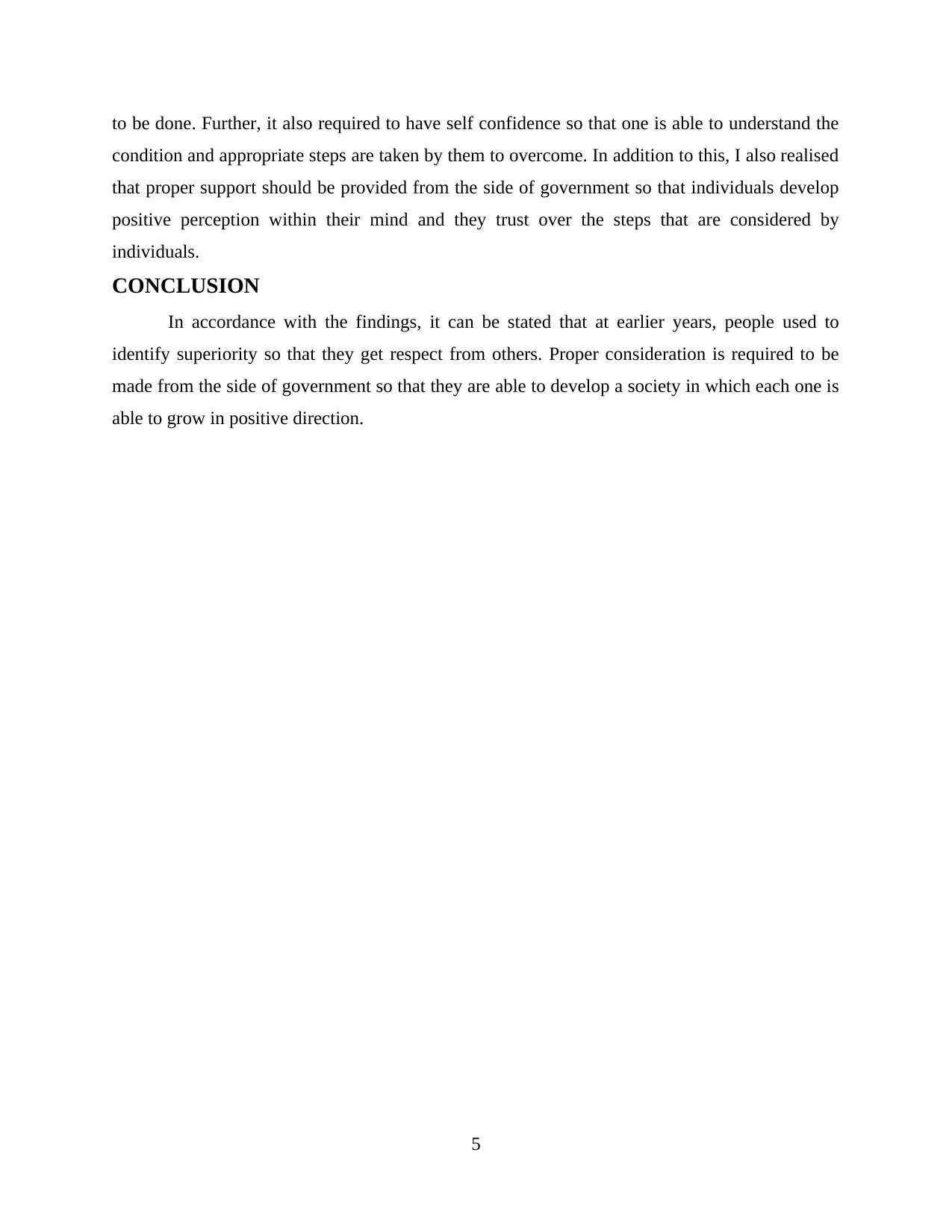
to be done. Further, it also required to have self confidence so that one is able to understand the
condition and appropriate steps are taken by them to overcome. In addition to this, I also realised
that proper support should be provided from the side of government so that individuals develop
positive perception within their mind and they trust over the steps that are considered by
individuals.
CONCLUSION
In accordance with the findings, it can be stated that at earlier years, people used to
identify superiority so that they get respect from others. Proper consideration is required to be
made from the side of government so that they are able to develop a society in which each one is
able to grow in positive direction.
5
condition and appropriate steps are taken by them to overcome. In addition to this, I also realised
that proper support should be provided from the side of government so that individuals develop
positive perception within their mind and they trust over the steps that are considered by
individuals.
CONCLUSION
In accordance with the findings, it can be stated that at earlier years, people used to
identify superiority so that they get respect from others. Proper consideration is required to be
made from the side of government so that they are able to develop a society in which each one is
able to grow in positive direction.
5
Paraphrase This Document
Need a fresh take? Get an instant paraphrase of this document with our AI Paraphraser
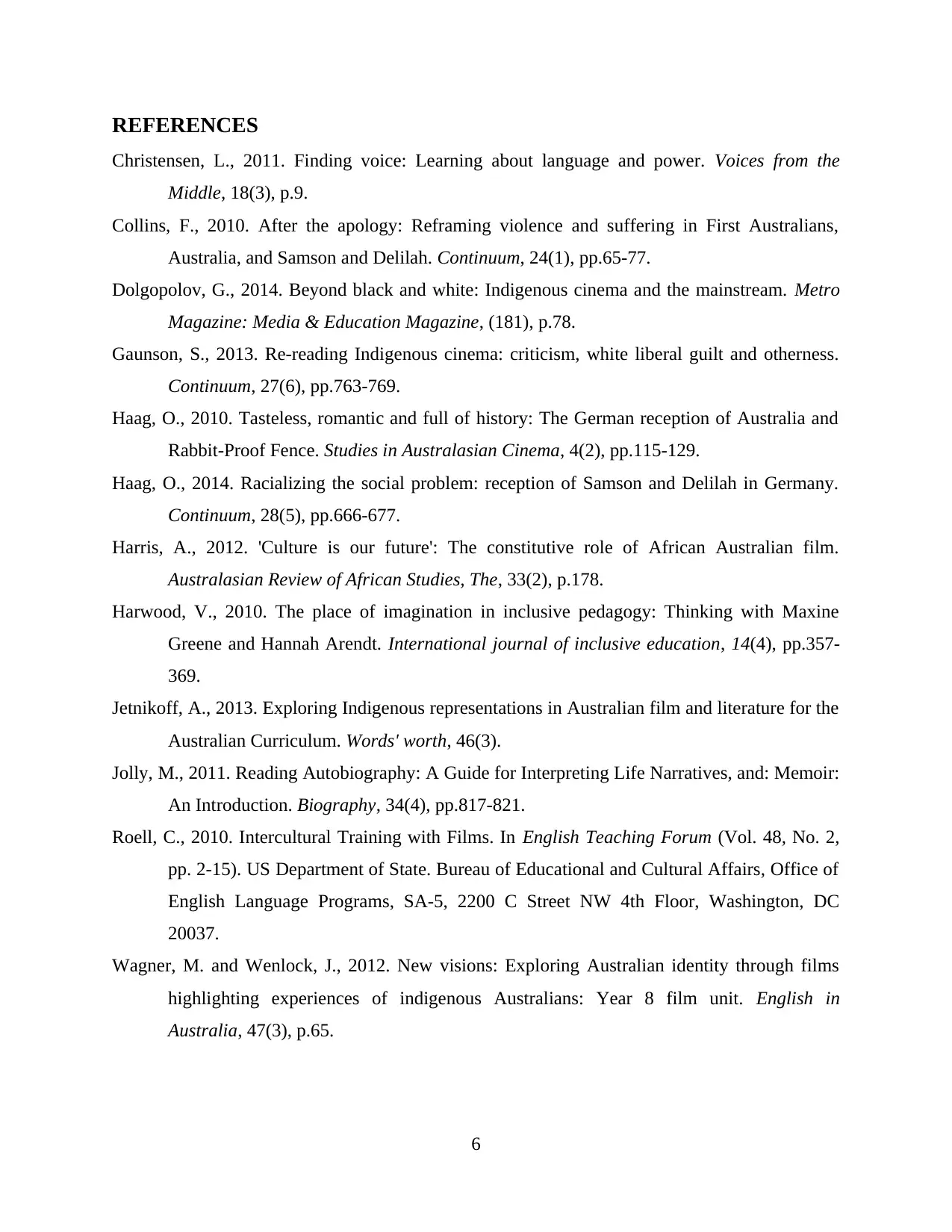
REFERENCES
Christensen, L., 2011. Finding voice: Learning about language and power. Voices from the
Middle, 18(3), p.9.
Collins, F., 2010. After the apology: Reframing violence and suffering in First Australians,
Australia, and Samson and Delilah. Continuum, 24(1), pp.65-77.
Dolgopolov, G., 2014. Beyond black and white: Indigenous cinema and the mainstream. Metro
Magazine: Media & Education Magazine, (181), p.78.
Gaunson, S., 2013. Re-reading Indigenous cinema: criticism, white liberal guilt and otherness.
Continuum, 27(6), pp.763-769.
Haag, O., 2010. Tasteless, romantic and full of history: The German reception of Australia and
Rabbit-Proof Fence. Studies in Australasian Cinema, 4(2), pp.115-129.
Haag, O., 2014. Racializing the social problem: reception of Samson and Delilah in Germany.
Continuum, 28(5), pp.666-677.
Harris, A., 2012. 'Culture is our future': The constitutive role of African Australian film.
Australasian Review of African Studies, The, 33(2), p.178.
Harwood, V., 2010. The place of imagination in inclusive pedagogy: Thinking with Maxine
Greene and Hannah Arendt. International journal of inclusive education, 14(4), pp.357-
369.
Jetnikoff, A., 2013. Exploring Indigenous representations in Australian film and literature for the
Australian Curriculum. Words' worth, 46(3).
Jolly, M., 2011. Reading Autobiography: A Guide for Interpreting Life Narratives, and: Memoir:
An Introduction. Biography, 34(4), pp.817-821.
Roell, C., 2010. Intercultural Training with Films. In English Teaching Forum (Vol. 48, No. 2,
pp. 2-15). US Department of State. Bureau of Educational and Cultural Affairs, Office of
English Language Programs, SA-5, 2200 C Street NW 4th Floor, Washington, DC
20037.
Wagner, M. and Wenlock, J., 2012. New visions: Exploring Australian identity through films
highlighting experiences of indigenous Australians: Year 8 film unit. English in
Australia, 47(3), p.65.
6
Christensen, L., 2011. Finding voice: Learning about language and power. Voices from the
Middle, 18(3), p.9.
Collins, F., 2010. After the apology: Reframing violence and suffering in First Australians,
Australia, and Samson and Delilah. Continuum, 24(1), pp.65-77.
Dolgopolov, G., 2014. Beyond black and white: Indigenous cinema and the mainstream. Metro
Magazine: Media & Education Magazine, (181), p.78.
Gaunson, S., 2013. Re-reading Indigenous cinema: criticism, white liberal guilt and otherness.
Continuum, 27(6), pp.763-769.
Haag, O., 2010. Tasteless, romantic and full of history: The German reception of Australia and
Rabbit-Proof Fence. Studies in Australasian Cinema, 4(2), pp.115-129.
Haag, O., 2014. Racializing the social problem: reception of Samson and Delilah in Germany.
Continuum, 28(5), pp.666-677.
Harris, A., 2012. 'Culture is our future': The constitutive role of African Australian film.
Australasian Review of African Studies, The, 33(2), p.178.
Harwood, V., 2010. The place of imagination in inclusive pedagogy: Thinking with Maxine
Greene and Hannah Arendt. International journal of inclusive education, 14(4), pp.357-
369.
Jetnikoff, A., 2013. Exploring Indigenous representations in Australian film and literature for the
Australian Curriculum. Words' worth, 46(3).
Jolly, M., 2011. Reading Autobiography: A Guide for Interpreting Life Narratives, and: Memoir:
An Introduction. Biography, 34(4), pp.817-821.
Roell, C., 2010. Intercultural Training with Films. In English Teaching Forum (Vol. 48, No. 2,
pp. 2-15). US Department of State. Bureau of Educational and Cultural Affairs, Office of
English Language Programs, SA-5, 2200 C Street NW 4th Floor, Washington, DC
20037.
Wagner, M. and Wenlock, J., 2012. New visions: Exploring Australian identity through films
highlighting experiences of indigenous Australians: Year 8 film unit. English in
Australia, 47(3), p.65.
6

7
1 out of 9
Your All-in-One AI-Powered Toolkit for Academic Success.
+13062052269
info@desklib.com
Available 24*7 on WhatsApp / Email
![[object Object]](/_next/static/media/star-bottom.7253800d.svg)
Unlock your academic potential
© 2024 | Zucol Services PVT LTD | All rights reserved.

